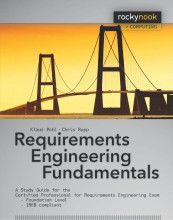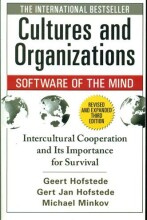Summary: Requirements Engineering Fundamentals A Study Guide For The Certified Professional For... | 9781457111921 | Klaus Pohl, et al
- This + 400k other summaries
- A unique study and practice tool
- Never study anything twice again
- Get the grades you hope for
- 100% sure, 100% understanding
Read the summary and the most important questions on Requirements Engineering Fundamentals A Study Guide for the Certified Professional for Requirements Engineering Exam - Foundation Level - IREB compliant | 9781457111921 | Klaus Pohl; Chris Rupp
-
1 Introduction and Foundations
This is a preview. There are 12 more flashcards available for chapter 1
Show more cards here -
What are quality requirements?
- A quality requirement is a requirement that pertains to a quality concern that is not covered by functional requirements
- @ The desired qualities of the system, e.g. (ISO 25010):
- Detailing functionalities (securaty, accurateness)
- Reliability
- Useability
- Efficiency
- Changeability
- Portability
-
What is a constraint
A constraint is a requirement that limits the solution space beyond what is necessary for meeting the given functional requirements and quality requirements. -
What is Requirement Engineering
Requirements engineering is a systematic and disciplined approach to the specification and management of requirements with the following goals:- knowing the relevant requirements, achieving a consensus among the stakeholders about these requirements, documenting them according to given standards and managing them systematically;
- understanding and documenting the stakeholders desires and needs, then specifying and managing the requirements to minimize the risk of delivering a system that does not meet these desires and needs.
-
What is a stakeholders
A stakeholder of a system is a person or an organisation that has an (direct or indirect) influence on the requirements of the system. -
Characteristics of the requirements engineer
The requirements engineer must have: domain knoledge, process knowledge, IT know-how;
Above all, good communication skills are essential: verbal, in writing.
Additionally, the requirements engineer must possess certain soft skills: analytical thinking, empathy, conflict resolution, moderation, self-confidence, ability to convince. -
1.1.1 Figures and Facts from Ordinary Projects
This is a preview. There are 1 more flashcards available for chapter 1.1.1
Show more cards here -
Symptoms of poor requirements engineering
- Unused system
- User dissatisfaction with developed system
- Unmet stakeholder requirements
- Unwanted features gettingimplemented
- Work executed through workarounds
- Unclear incomplete or wrong requirements lead to development of wrong solutions.
- Costs of fixing errors increase exponentially with each project phase.
- Unused system
-
1.1.2 Requirements Engineering - What Is It?
This is a preview. There are 2 more flashcards available for chapter 1.1.2
Show more cards here -
What is a requirement
- A condition or capability needed by a user to solve a problem or achieve an objective;
- A condition of capability that must be met or possessed by a system component to satisfy a contract, standard, specification or other formally imposed documents;
- A documented representation of a condition of capability as in (1) or (2).
- A requirement may be unstated, implied by or derived from other requirements, or directly stated and managed.
- Requirements describe, but not limited to, past, present and future conditions or capabilities in an enterprise, organizational structures, roles, processes, policies, rules and information systems.
-
Four core activities of requirements engineering
Elicitation (Obtain requirements form stakeholders) - Documentation (elicited requirements are described adequately)
- Validation & Negotiation (guarantee that predefined quality criteria are met, documented requirements must be validated and negotiated)
- Management
-
Requirements engineering consists of two parts, which?
- Requirements development (gericht op identificeren, verzamelen en ontwikkelen van requirements van de stakeholder)
- Requirements management (beheren van de requirment van creatie tot uitfaseren)
-
What are the different levels of requirements?
- Business - VB: Wat heeft het bedrijf nodig, een CRM systeem
- Stakeholders - VB: Wat zijn de wensen van de stakeholders; tester/ gebruiker etc.
- Solution - VB: Functioneel / Non-Functioneel
- Transition
- Business - VB: Wat heeft het bedrijf nodig, een CRM systeem
- Higher grades + faster learning
- Never study anything twice
- 100% sure, 100% understanding
Topics related to Summary: Requirements Engineering Fundamentals A Study Guide For The Certified Professional For...
-
Introduction and Foundations - Characteristics of a requirements Engineer
-
Introduction and Foundations - Requirement Types
-
System and Context Boundaries
-
Eliciting Requirements - Requirements Sources
-
Eliciting Requirements - Requirements Categorization According to the Kano Model
-
Eliciting Requirements - Elicitation Techniques
-
Documenting Requirements - Document Design
-
Documenting Requirements - Types of Documentation
-
Documenting Requirements - Glossary
-
Documenting Requirements in Natural Language - Effects of Natural Language
-
Documenting Requirements in Natural Language - Requirement Construction using Templates
-
Model-Based Requirements Documentation
-
Requirements Validation and Negotiation
-
Reuirements Management - Traceablity of Requirements
-
Reuirements Management - Versioning of Requirements
-
Reuirements Management - Management of Requirements Changes
-
Tool Support - Evaluating Tools

































